Millets-The Nutri-cereals
Millets-The Nutri-cereals
- Summary
- Key Takeaways
- Introduction
- Nutritional Composition of various types of Millets with their Local Name
- Major Millets
- Minor Millets
- Foxtail millet (Kakum)
- Kodo millets (Kodon)
- Barnyard millet (Sanwa)
- Little millet (Kutki/Shavan)
- Proso millet (Chenna/Barri)
- Pseudo Millets
- Why one should eat millets?
- What are the Health benefits of Millets?
- Facts about Millets
- Provisions under Food Safety and Standards Act 2006
Summary
Millets are group of small grained cereal food crops which are highly tolerant to drought and other extreme weather conditions and are grown with low chemical inputs such as fertilizers and pesticides. Most of millet crops are native of India and are popularly known as Nutri-cereals as they provide most of the nutrients required for normal functioning of human body. Millets are classified into Major Millets and Minor Millets based on their grain size. Pseudo millets are so called because they are not part of the Poaceae botanical family, to which ‘true’ grains belong, however they are nutritionally similar and used in similar ways to ‘true’ grains.
Ministry of Agriculture and Farmers Welfare has recognized the importance of Millets and declared Millets comprising of Sorghum (Jowar), Pearl Millet (Bajra), Finger Millet (Ragi/Mandua), Minor Millets i.e., Foxtail Millet (Kanngani/kakun), Proso Millet (Cheena), Kodo Millet (Kodo), Barnyard Millet (Sawa/Sanwa/Jhangora), Little Millet (Kutki), Brown top millet and two pseudo millets i.e., Buck- wheat (Kuttu), Amaranth (Chaulai)) as “Nutri-Cereals” for production, consumption and trade point of view.
Millets are gluten free and non- allergenic. Millet consumption decreases triglycerides and C- reactive protein, thereby preventing cardiovascular disease. All millets are rich in dietary fibre. Dietary fibre has water absorbing and bulking property. It increases transit time of food in the gut which helps in reducing risk of inflammatory bowel disease and acts as detoxifying agent in the body.
Key Takeaways
- Most of millet crops are native of India and are group of small grained cereal food crops which are highly nutritious.
- Millets are popularly known as Nutri-cereals as they provide most of the nutrients
- required for normal functioning of human body.
- Millets are Gluten free and good for people who are gluten-intolerant.
- Prefer to buy Multi grain processed food products like Multigrain Atta, Multigrain Biscuits, Multigrain Bread etc having millets as one of the ingredient.
- Don’t buy, if odour is unpleasant and taste is bitter or gritty. Avoid millets if living or dead insects are visible in the product.
- Prefer millets in packed form and certified under AGMARK.
- Check FSSAI license number on the package label.
- Always read the manufacturing/ packaging date and best before date before buying.
- Look for FSSAI Organic logo (Jaivik Bharat) on the pack while buying organic food products.
Introduction
Millets are traditional grains, grown and consumed in the Indian subcontinent from the past more than 5000 years. Millets are small - grained, annual, warm - weather cereals belonging to grass family. They are rain - fed, hardy grains which have low requirements of water and fertility when compared to other popular cereals. They are highly tolerant to drought and other extreme weather conditions.
Millets are nutri cereals comprising of sorgum, pearl millet, finger millet (Major millets) foxtail, little, kodo, proso and barnyard millet (minor millets). These are one of thge oldest foods known to humanity. These are one of the several species of coarse cereal grasses in the family poaceae, cultivated for their small edible seeds. Pseudo millets are so called because they are not part of the Poaceae botanical family, to which 'true' grains belong, however they are nutritionally similar and used in similar ways to 'true' grains.
Millets are highly nutritious, non-glutinous and non acid forming foods. Millets have many nutraceutical and health promoting properties especially the high fibre content. Millets act as a probiotic feeding for micro - flora in our inner ecosystem. Millets hydrate our colon to keep us from being constipated. Niacin in millet can help lower cholesterol. Millets contain major and minor nutrients in good amount along with dietary fibre. Millets are gluten free and can be a substitute for wheat or gluten containing grains for celiac patients.
Nutritional Composition of various types of Millets with their Local Name
Millets are high in nutrition and dietary fibre. They serve as good source of protein, micronutrients and phytochemicals. The millets contain 7-12% protein, 2-5% fat, 65-75% carbohydrates and 15-20% dietary fibre. The essential amino acid profile of the millet protein is better than various cereals such as maize. Millets contain fewer cross-linked prolamins, which may be an additional factor contributing to higher digestibility of the millet proteins.
Similar to cereal proteins, the millet proteins are poor sources of lysine, but they complement well with lysine - rich vegetables (leguminous) and animal proteins which form nutritionally balanced composites of high biological value. Millets are more nutritious compared to fine cereals. Small millets are good source of phosphorous and iron.
Millets contributes to antioxidant activity with phytates, polyphenols, tannins, anthocyanins, phytosterols and pinacosanols present in it having important role in aging and metabolic diseases. All millets possess high antioxidant acitivities.
Major Millets
Sorghum (Jowar)
- Major portion of sorghum protein is prolamin (kaffirin) which has a unique feature of lowering digestibility upon cooking which might be a health benefit for certain dietary groups.
- Sorghum proteins upon cooking are significantly less digestible than other cereal proteins, which might be a health benefit for certain dietary groups.
- It is rich in protein, fibre, thiamine, riboflavin, folic acid, and carotene.
- It is rich in potassium, phosphorus and calcium with sufficient amounts of iron, zinc and sodium.
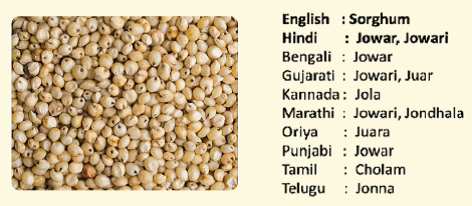
Pearl Millet (Bajra)
- Pearl millet contains considerably high proportion of proteins (12-16%) as well as lipids (4-6%).
- It contains 11.5% of dietary fiber. It increases transit time of food in the gut. Hence, reduce risk of inflammatory bowel disease.
- The niacin content in pearl millet is higher than all other cereals.
- It also contains folicate, magnesium, iron, copper, zinc and vitamins E and B- complex. It has high energy content compared to other millets.
- It is also rich in calcium and unsaturated fats which are good for health.
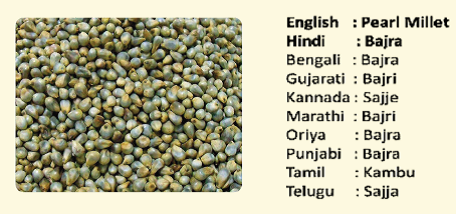
Finger Millet (Ragi)
- Finger millet is the richest source of calcium (300-350 mg/100g)
- Ragi has the highest mineral content.
- It contains lower levels of protein (6-8%) and fat (1.5-2%)
- Finger millet proteins are unique because of the sulphur rich amino acid contents.
- The grains have excellent malting properties and are widely known for its use as weaning foods.
- It has high antioxidant activity.
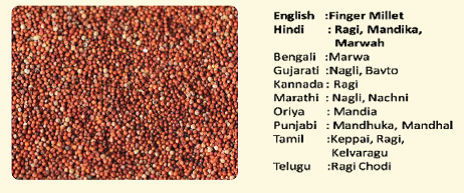
Minor Millets
Foxtail millet (Kakum)
- It is high in carbohydrates.
- It has double quantity of protein content compared to rice.
- It contains minerals such as copper & iron.
- It provides a host of nutrients, has a sweet nutty flavour and is considered to be one of the most digestible and non - allergic grains.
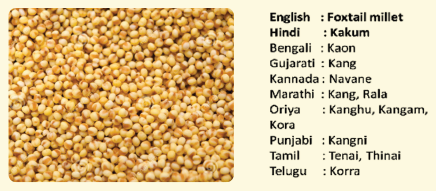
Kodo millets (Kodon)
- It has high protein content (11%), low fat (4.2%) and very high fibre content (14.3%).
- Kodo millet is rich in B vitamins especially niacin, pyridoxin and folic acid as well as the minerals such as calcium, iron, potassium, magnesium and zinc.
- It contains a high amount of lecithin and is an excellent for strengthening the nervous system.
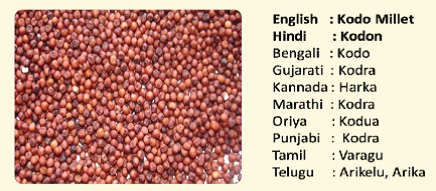
Barnyard millet (Sanwa)
- It is the richest source of crude fiber and iron.
- Its grains possess other functional constituents i.e., Gamma amino butyric acid (GABA) and Beta - glucan, used as antioxidants and in reducing blood lipid levels.
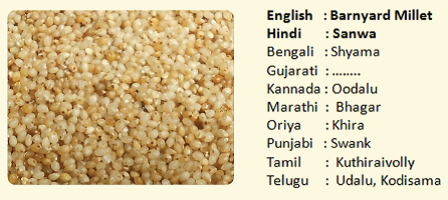
Little millet (Kutki/Shavan)
- It is smaller than other millets.
- It is high in iron content.
- It has high antioxidant activities.
- It contains about 38% of dietary fiber.
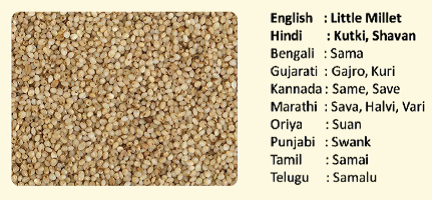
Proso millet (Chenna/Barri)
- It contains the highest amount of proteins (12.5%).
- Health benefits of proso millet come from its unique properties. It has significant amounts of carbohydrate and fatty acids.
- It is cheaper source of manganese as compared to other conventional sources like spices and nuts.
- It contains high amounts of calcium which is essential for bone growth and maintenance.
- It reduces cholesterol levels and also reduce the risk of heart diseases
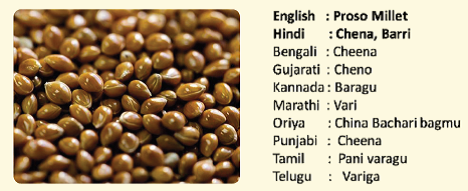
Pseudo Millets
Amaranth (Ramdana/ Rajgira)

- High protein content (13-14%) and a carrier of lysine, an amono acid that's missing or negligible in many other grains.
- Consists of 6 to 9% of oil which is higher than most other cereals. Amaranth oil contains approximately 77% unsaturated fatty acids and is high in linoleic acid.
- It is high in dietary fibre.
- High in iron,magnesium, phosphorus, potassium and appreciable amounts of calcium.
- A rich dietary source of phytosteriols, with cholesterol - lowering properties.
- Contains a lunasin - like peptide and other bioactive peptides which are thought to have cancer - preventive and antihypertensive properties.
Buckwheat (Kuttu)
- It contains protein 13-15% protein and rich in the amino acid lysine.
- Rich in carbohydrates (mainly starch).
- Contains vitamins B1, C and E.
- Rich in polyunsaturated essential fatty acids, such as linoleic acid.
- Contains higher levels of zinc, copper, and manganese than other cereal grains, and the bioavailability of these minerals is also quite high.
- High in soluble fibre.
- A rich source of polyphenol compounds.
- Contains rutin, a bioflavonoid thought to help control blood pressure and possess anti - inflammatory and anti - carcinogenic properties.
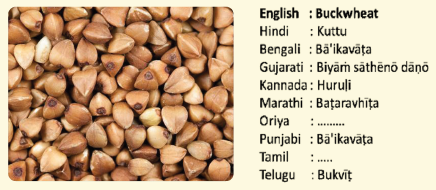
Why one should eat millets?
Millets are gluten-free, highly nutritious and rich in dietary fibre. They are rich in micronutrients, including calcium, iron, phosphorus, etc. They are low in Glycemic Index (GI) as such don't cause huge spike in blood sugar. Millets should ideally be an integral part of our daily diet.
Dietary fibre in millets has water absorbing and bulking property. It increases transit time of food in the gut which helps in reducing risk of inflammatory bowel disease and acts as detoxifying agent in the body.
What are the Health benefits of Millets?
- Millets are anti acidic;
- Millets are gluten free;
- Helps to prevent type 2 diabetes;
- Effective in reducing blood pressure;
- Reduces risk of gastrointestinal conditions like gastric ulcers or colon cancer;
- Eliminate problems like constipation, excess gas, bloating and cramping;
- Millet act as a probiotic feeding micro flora in our inner ecosystem.
Facts about Millets
Can celiac patients consume millets?
Yes. The millets do not contain gluten and therefore, safe for consumption in case of gluten sensitivity.
Are millets healthy for consumption by infants or aged people?
Millets are easy - to - digest and full of nutrients and therefore, ideally suitable for consumption by every age group.
Do millets prevent Cardiovascular disease?
Millet consumption decreases triglycerides and C - reactive protein, thereby preventing cardiovascular disease.
Provisions under Food Safety and Standards Act 2006
Standards of Sorghum (Jowar) and its flour, Whole and decorticated pearl millet grain (Bajra) and its flour, Finger Millet (Ragi) and Amaranth are prescribed in the sub regulation 2.4 of Food Safety & Standards (Food Product Standards and Food Additives) Regulations, 2011.
These regulations are available on FSSAI website https://www.fssai.gov.in/
Source: FSSAI
Last Modified : 9/14/2022
This topic deals with information related to Anxie...
The Article provides information about Antioxidant...
This topic deals with information related to Appen...
This topic provides information about 20th Livesto...
